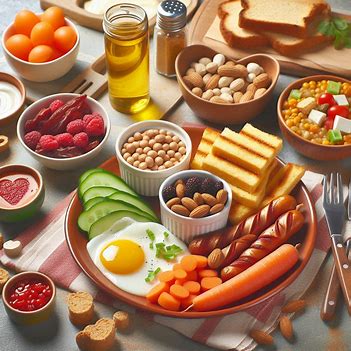Meal Plans
A comfort food meal plan can still be heart-healthy

A comfort food meal plan can still be heart-healthy and support lowering high cholesterol. By focusing on foods that are satisfying yet low in saturated fats and high in fiber, you can enjoy comforting meals that help reduce cholesterol levels. Here’s a breakdown of a meal plan filled with healthy fats, fiber, and nutrient-rich ingredients while avoiding processed and high-cholesterol foods.
Key Ingredients for Lowering Cholesterol:
- Soluble Fiber: Helps lower LDL (bad) cholesterol by binding to cholesterol in the gut and removing it from the body. Foods rich in soluble fiber include oats, beans, lentils, fruits (like apples, berries, and citrus), and vegetables.
- Healthy Fats: Replace saturated fats with unsaturated fats, especially omega-3 fatty acids found in fatty fish, flaxseeds, and walnuts.
- Plant Sterols/Stanols: Naturally found in nuts, seeds, whole grains, fruits, and vegetables, these compounds can block the absorption of cholesterol in the digestive system.
- Nuts and Seeds: Almonds, walnuts, flaxseeds, and chia seeds provide healthy fats and fiber.
- Low-Fat Dairy: Opt for low-fat or plant-based dairy alternatives to reduce saturated fat intake.
- Lean Protein: Focus on plant-based proteins (lentils, beans) or lean meats like skinless poultry and fish.
Sample Comfort Food Meal Plan to Lower Cholesterol
Breakfast Options
- Oatmeal with Berries and Almonds
- Ingredients: Steel-cut oats, blueberries or strawberries, ground flaxseeds, and a handful of almonds.
- Why It Works: Oats are rich in soluble fiber (beta-glucan), which helps reduce LDL cholesterol. Berries are packed with antioxidants, and almonds provide healthy fats.
- Comfort Factor: Warm, hearty, and naturally sweet.
- Avocado Toast with a Poached Egg
- Ingredients: Whole grain bread, mashed avocado, a poached egg, and a sprinkle of chia seeds.
- Why It Works: Avocado provides heart-healthy monounsaturated fats, while the egg offers protein without raising cholesterol significantly (limit eggs to a few per week).
- Comfort Factor: Creamy and filling.
- Smoothie Bowl
- Ingredients: Spinach, banana, berries, almond milk, chia seeds, and walnuts.
- Why It Works: Packed with fiber, antioxidants, and omega-3 fatty acids from chia seeds and walnuts.
- Comfort Factor: Cold, refreshing, and customizable with your favorite fruits.
Lunch Options
- Lentil and Vegetable Soup
- Ingredients: Lentils, carrots, celery, garlic, spinach, tomatoes, and vegetable broth.
- Why It Works: Lentils are high in soluble fiber and protein, helping to lower cholesterol while keeping you full.
- Comfort Factor: Warm, hearty, and satisfying.
- Quinoa Salad with Avocado, Black Beans, and Lime Vinaigrette
- Ingredients: Quinoa, black beans, avocado, cherry tomatoes, corn, and lime dressing.
- Why It Works: Quinoa is a whole grain high in fiber, and black beans are packed with cholesterol-lowering soluble fiber. Avocado adds healthy fats.
- Comfort Factor: Light yet filling with a refreshing, tangy twist.
- Grilled Chicken and Veggie Wrap
- Ingredients: Whole grain tortilla, grilled skinless chicken breast, hummus, spinach, cucumbers, and bell peppers.
- Why It Works: Lean chicken and fiber-rich veggies make this a cholesterol-friendly, satisfying option.
- Comfort Factor: A delicious handheld meal that’s easy to customize.
Dinner Options
- Salmon with Roasted Vegetables and Quinoa
- Ingredients: Salmon fillet, olive oil, roasted vegetables (carrots, broccoli, and zucchini), and quinoa.
- Why It Works: Salmon is rich in omega-3 fatty acids, which help reduce triglycerides and LDL cholesterol. Roasted veggies and quinoa provide fiber and essential nutrients.
- Comfort Factor: A warm, nutrient-dense meal that feels indulgent yet heart-healthy.
- Vegetable Stir-Fry with Tofu
- Ingredients: Tofu, broccoli, bell peppers, carrots, mushrooms, garlic, ginger, low-sodium soy sauce, and brown rice.
- Why It Works: Tofu is a plant-based protein that’s low in cholesterol, and the fiber-rich vegetables help improve cholesterol levels.
- Comfort Factor: Warm and flavorful, with plenty of satisfying textures.
- Turkey Chili
- Ingredients: Lean ground turkey, kidney beans, black beans, tomatoes, onions, garlic, chili powder, and spices.
- Why It Works: Beans are excellent sources of fiber that help reduce LDL cholesterol. Lean turkey keeps the dish lower in saturated fat.
- Comfort Factor: A cozy, one-pot meal that’s hearty and filling.
Snack Options
- Apple Slices with Almond Butter
- Why It Works: Apples are rich in soluble fiber, and almond butter adds healthy fats that lower cholesterol.
- Comfort Factor: Sweet, crunchy, and satisfying.
- Carrot Sticks with Hummus
- Why It Works: Carrots are high in fiber, and hummus (made from chickpeas) provides plant-based protein and fiber.
- Comfort Factor: Creamy and crunchy.
- Greek Yogurt with Walnuts and Honey
- Why It Works: Choose low-fat Greek yogurt for protein and probiotics, while walnuts add omega-3 fatty acids and fiber. A drizzle of honey provides natural sweetness.
- Comfort Factor: Creamy and indulgent without being too heavy.
Tips for Success:
- Limit Saturated and Trans Fats: Avoid red meat, full-fat dairy, butter, and processed foods that can raise cholesterol.
- Increase Soluble Fiber: Incorporate oats, beans, lentils, and fruits regularly, as they bind to cholesterol and help remove it.
- Choose Plant-Based Proteins: Legumes, tofu, and nuts are excellent cholesterol-friendly protein sources.
- Cook with Healthy Fats: Use olive oil or avocado oil for cooking, as they provide heart-healthy monounsaturated fats.
- Use Herbs and Spices: Season meals with garlic, ginger, turmeric, and other herbs and spices, which can have anti-inflammatory and cholesterol-lowering properties.
Conclusion
A comforting yet cholesterol-lowering meal plan doesn’t have to sacrifice flavor or satisfaction. By focusing on fiber-rich foods, lean proteins, and healthy fats, you can create delicious meals that support heart health while satisfying your cravings. Keep your meals balanced and rich in whole foods, and limit high-cholesterol ingredients to maintain a heart-healthy lifestyle.
